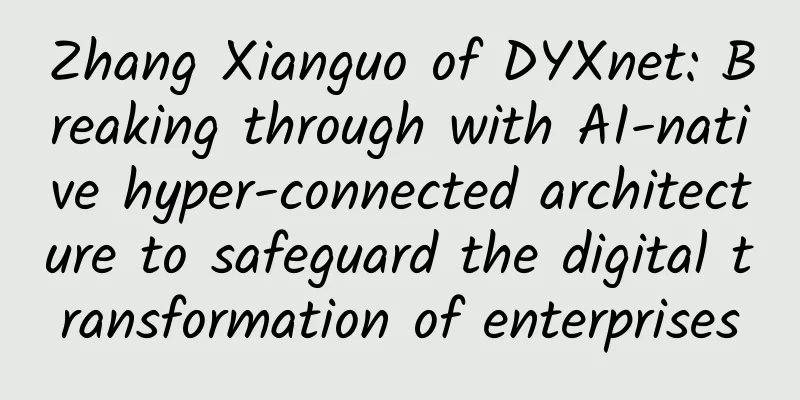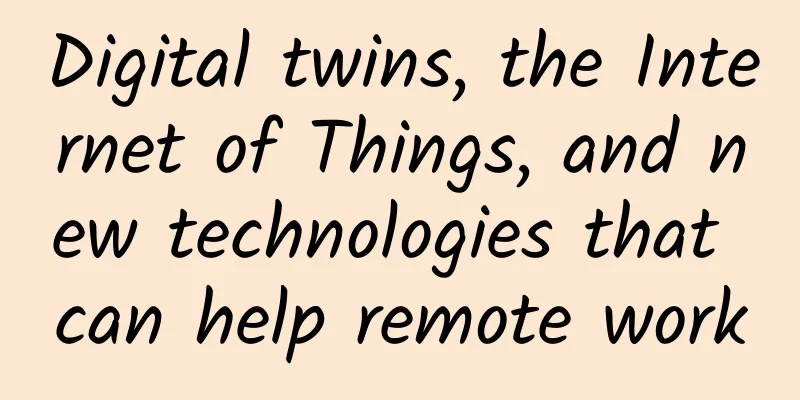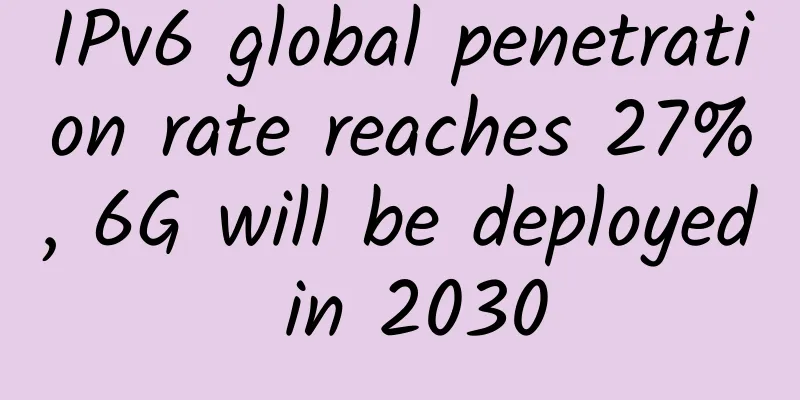Zhang Xianguo of DYXnet: Breaking through with AI-native hyper-connected architecture to safeguard the digital transformation of enterprises

|
In today's digital era, AI and large model applications have become key technologies to promote enterprise innovation and sustainable development. With the continuous development of technology, the private deployment of large models has become an increasingly obvious trend. On the one hand, model customization for specific business scenarios can better meet the actual needs of enterprises and promote business development; on the other hand, the deployment of private large models can ensure data security and privacy protection, and data does not need to be leaked, reducing the risk of data leakage. However, when enterprises balance traditional businesses and deploy private large-scale model businesses, they face challenges in computing power, network, data security and other aspects, forcing them to seek new technologies and solutions to deal with these problems. As a provider of " AI+ cloud network security services", DYXnet has keenly noticed this trend and is committed to building an AI- native hyper-connected architecture to meet the needs of enterprises in the process of digital transformation. Zhang Xianguo, director of DYXnet Intelligent Computing Network Technology Department, said in a recent interview with 51CTO that in the past, data was only stored in business databases, and enterprises only performed simple searches on them, making it difficult for many unstructured data to realize their value. But now, with the help of AI capabilities, data value can be better released. For enterprises, the key is how to maximize the value of private data while protecting their own data and avoid making their data just part of a large platform. This is the real value of the future transformation of enterprises. With the full opening of the big model era, DYXnet has kept up with the higher requirements of enterprises for security, AI , computing power, etc. Through technological innovation and ecological cooperation, it has built an AI- native hyper-interconnected architecture infrastructure, achieved a deep integration of computing power and network, and provided enterprises with an enterprise trusted computing space that integrates AI computing power, private domain data, models, and privacy computing, which can support enterprise innovation in the AI- native field. Adapting to the trend, evolving from network enablement to AI+ cloud network security service providerIn a complex and fierce market environment, innovation has become the foundation for enterprises to gain competitive advantages and achieve sustainable development. Friends who are familiar with DYXnet know that this company, founded in 1999 , has always been growing at a high speed and adapting to every trend change. From the initial telecom neutral network service provider to the world's leading "AI+ Cloud Network Security " service provider, DYXnet continues to be at the forefront of innovation, constantly breaking through itself and leading the development of the industry. Zhang Xianguo told 51CTO that in its 25 years of development, DYXnet has always adhered to the concept of "empowering enterprise growth with service innovation", starting from providing MPLS VPN services to launching the industry's first SD-WAN network, continuously upgrading service quality, supporting the close coordination of enterprises' global digital application scenarios, and building core network service capabilities covering more than 700 cities around the world. Entering the era of AI and big models, more and more companies are beginning to explore the application of big models in enterprise business scenarios. Deploying private big model applications has become a core technology to promote the rapid development of enterprises. Zhang Xianguo said that with the deepening development of big models, more and more companies are starting to upgrade to digital intelligence. The privatization of big models is showing an increasingly obvious trend. Only when companies integrate private data, professional knowledge and industry experience into big models, and then create AI- native business forms, and let the models generate content that is more in line with the actual and professional needs of the company, can they provide companies with more targeted decision-making support and solutions, and thus better help companies gain competitive advantages. During the interview, Zhang Xianguo took the financial industry as an example and introduced in detail the important role that big models play in promoting corporate innovation. He said that financial institutions can train exclusive financial big models for business scenarios such as risk assessment and investment decision-making, so that they can handle complex business problems more accurately. However, in the process of training exclusive big models for enterprises, higher requirements are placed on data security, network and computing power. This requires the integration of multiple factors such as computing power, big models and private data, and ensuring that the new architecture can provide support for privacy and security. In the following time, Zhang Xianguo shared in detail the many challenges that enterprises face in the process of deploying private large-scale model applications. First, there are challenges brought by the surge in demand for computing power. In the large model training phase, due to the huge number of parameters and training data sets, there are extremely high requirements for computing power. Taking the financial industry as an example, the amount of data that needs to be processed when training a dedicated financial large model is often tens of terabytes or even PBs . However, the current market has tight GPU resources and high computing power costs. How to effectively use computing power resources has become a major problem facing enterprises. Secondly, there are the dual pressures of network bandwidth and network security. AI -native business intelligence is built based on enterprise private data and applications, and the amount of data transmission is huge. The internal network of an enterprise needs to support high-speed interconnection from the data end to the computing end, and the demand for network bandwidth has surged. At the same time, with the continuous escalation of network attack methods, enterprises are facing unprecedented network security pressure. How to ensure data security and non-leakage while ensuring data transmission efficiency has become an urgent problem that enterprises need to solve. Finally, there is the problem of data privacy protection. As the core asset of enterprises, data leakage and privacy violations have occurred frequently in recent years, making enterprises increasingly worried about data privacy protection. How to ensure data privacy security during large model training has become an important issue that enterprises must face. Zhang Xianguo emphasized that driven by the new trend, DYXnet is committed to bringing together innovative technologies and AI computing resources to build an AI- native hyper-interconnected architecture to support the comprehensive upgrade of enterprise AI nativeization. Born out of the trend, using AI-native hyperconnected architecture to empower enterprise transformationBased on a deep insight into enterprise needs, with profound technical accumulation and rich industry experience, DYXnet has created an AI- native hyper-connected architecture and launched a series of innovative products and solutions to help enterprises cope with challenges in computing power, networking, security and other aspects. According to Zhang Xianguo, the Dianxian AI native hyper-interconnected architecture realizes a high-speed and secure channel for direct computing power between parks and buildings, solving the problems of tight computing resources and surging demand for data transmission, and helping enterprises to achieve large-scale model training based on private data while achieving a higher level of data security. In terms of AI computing power, DYXnet integrates AI computing resources from multiple parties to form a service platform with diversified computing power support. At the network level, DYXnet has created an innovative AI- native hyper-interconnected architecture based on remote RDMA and other technologies, and uses dynamic slicing technology to dynamically switch networks. When customers need high computing power, they can quickly allocate a high-bandwidth, secure and private direct network and open up bandwidth of more than 100G for them, ensuring fast and efficient interconnection between massive data and computing power terminals, and automatically releasing resources after the task is completed. In terms of data security, DYXnet has built a privacy computing platform and created end-to-end encryption + post-computation release capabilities. First, DYXnet has enhanced the real-time large-bandwidth encryption capability in the network to ensure that the data transmission between the client and the computing power server is fully encrypted. When the enterprise establishes a connection with the computing power end, it will obtain computing network support with both performance and security, while ensuring that the data will not be transmitted externally. Secondly, all computing servers will only have memory but no hard disk, realizing diskless privacy computing, and private data will be cleared after calculation. This means that after the calculation is completed, the result will be transmitted back, and then the relevant data will be cleared. When other customers use it next time, a dynamic private connection will be established to carry out new computing services in the memory space. After the calculation is completed, no traces will be left or saved. In this way, it can be ensured that the data only exists in the private computing space within the current computing time and space, and users can use the relevant computing services with confidence. During the interview, Zhang Xianguo also used a case to give a detailed introduction to First-Line's practices in helping enterprises deploy private large-scale model applications. According to reports, taking an educational enterprise as an example, DYXnet built a new private domain for it to store data and provided computing power dedicated network services. By building the data into a knowledge base in the form of a private vector database and connecting it with the privacy computing power provided by DYXnet, fine-tuning training is performed using privacy computing power. During the training process, all data is processed in the private domain space to ensure that it will not be transmitted externally. Finally, a new AI model is trained and deployed on the public network for use by educational enterprise users. At present, the first-line ICT services have evolved from network empowerment to a full-stack service system of AI+ cloud network security, empowering more than 2,000 corporate customers. Seizing the opportunity, we continue to explore the integration and upgrade of AINEtTalking about the overall development plan of DYXnet, Zhang Xianguo said that in the face of the development trend of AI , DYXnet is committed to upgrading to AI applications and large model services + AI native infrastructure services. For AI native infrastructure services, one of DYXnet's strategic directions is to build AINet . In this strategy, DYXnet has taken the following two routes: The first route is to innovate at the traditional business level. This includes SD-WAN/MPLS VPN , core network architecture, and SASE security. Currently, DYXnet is working to combine these technologies with AI to achieve the following goals: intelligent prediction of traffic through SD-WAN/MPLS VPN+AI ; core network +AI to build InsightNet intelligent network; integrate SASE 's AI capabilities into SASE POP at the edge of the core network to create an intelligent security protection system. The second route is to create an AI- native hyper-connected architecture to meet the future needs of enterprise AI- native upgrades. AINet , formed by the convergence of two-way routes, will provide services that enable the network to move on demand and the linkage of two networks, and provide intelligent basic foundation support for various scenarios such as training and reasoning of enterprise AI business applications. At the end of the interview, Zhang Xianguo said that DYXnet will continue to explore and promote the integration of AI capabilities and cloud network security services to create emerging service capabilities such as smart infrastructure services and smart application services, and work with enterprises to jointly achieve data value. Editor's opinion: The many challenges brought about by the private deployment of large models have given rise to new technologies and solutions. It is with keen industry insight and strong technical strength that DYXnet has created an AI native hyper-interconnected architecture in the process of continuous transformation and upgrading, helping enterprises solve various problems encountered in the private deployment of large models, meeting the needs of traditional businesses and making it easier for enterprises to deploy private large model applications, laying a solid foundation for continuous business innovation and development. I believe that in the future, with the continuous development of AI technology and the continuous expansion of application scenarios, DYXnet will continue to deepen its ICT service field, and continue to upgrade to AI applications and large model services + AI native infrastructure services, to provide enterprises with more and better solutions and services. |
Recommend
edgeNAT newly launched Korean CN2 line native IP host monthly payment starts from 80 yuan
This month, edgeNAT launched a new Korean native ...
CloudCone Christmas promotion, Los Angeles MC data center KVM VPS annual payment starts from $12.7
CloudCone is a sub-brand of Quadcone, founded in ...
Why TCP/IP is a threat to the Internet of Things
This article is reproduced from the WeChat public...
What will the Internet look like in 10 years?
The Internet has evolved tremendously over the pa...
5G accelerates the energy revolution, and future development trends are becoming increasingly clear
In today's world, the importance of energy is...
Emoji.voto, a sample application for Linkerd service mesh
[[412321]] A microservice application that allows...
5G messaging: The key is how to divide the money
[[439892]] The 5G news that had just been quiet i...
Maxthon Hosting 20% off on all VPS: US/Hong Kong/Germany/Netherlands CN2 line 2G memory package starting from 54.4 yuan per month
Maxthon Hosting still offers a 20% discount code ...
Zhao Houlin: Broadband development has made remarkable achievements, but there are still considerable challenges. The global industry needs to fully cooperate.
The digital divide has not yet disappeared, and t...
What is the difference between LoRa and LoRaWAN?
LoRa, or Long Range, is a proprietary low-power, ...
How 5G can help realize massive IoT
When discussing the coming 5G era, attention is o...
5G and Wi-Fi 6, the next generation of infrastructure?
Cellular and Wi-Fi networks have come together to...
The development trend of enterprise-level wireless coverage (WiFi6)
[[402903]] 1. Trends in enterprise-level wireless...
5G uses millimeter waves, what will 6G/7G use? Experts have given the answer
With the commercialization approaching, the topic...
Understanding the new features of HTTP/2 and HTTP/3 (recommended)
Compared with HTTP/1.1, HTTP/2 can be said to hav...









